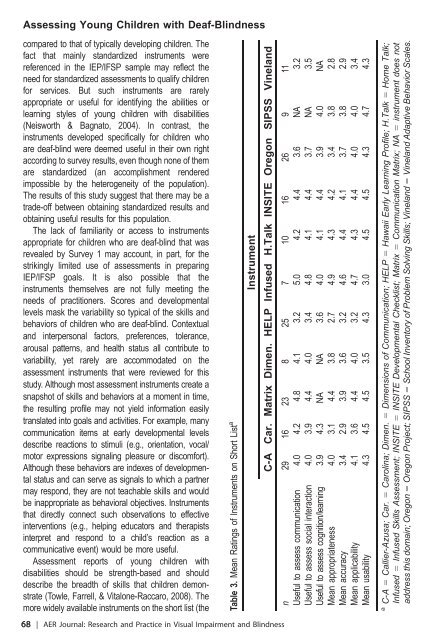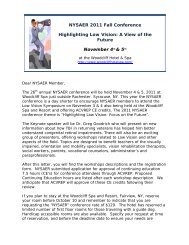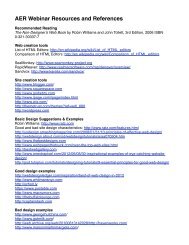Association for Education and Rehabilitation of the ... - AER Online
Association for Education and Rehabilitation of the ... - AER Online
Association for Education and Rehabilitation of the ... - AER Online
Create successful ePaper yourself
Turn your PDF publications into a flip-book with our unique Google optimized e-Paper software.
Assessing Young Children with Deaf-Blindness<br />
compared to that <strong>of</strong> typically developing children. The<br />
fact that mainly st<strong>and</strong>ardized instruments were<br />
referenced in <strong>the</strong> IEP/IFSP sample may reflect <strong>the</strong><br />
need <strong>for</strong> st<strong>and</strong>ardized assessments to qualify children<br />
<strong>for</strong> services. But such instruments are rarely<br />
appropriate or useful <strong>for</strong> identifying <strong>the</strong> abilities or<br />
learning styles <strong>of</strong> young children with disabilities<br />
(Neisworth & Bagnato, 2004). In contrast, <strong>the</strong><br />
instruments developed specifically <strong>for</strong> children who<br />
are deaf-blind were deemed useful in <strong>the</strong>ir own right<br />
according to survey results, even though none <strong>of</strong> <strong>the</strong>m<br />
are st<strong>and</strong>ardized (an accomplishment rendered<br />
impossible by <strong>the</strong> heterogeneity <strong>of</strong> <strong>the</strong> population).<br />
The results <strong>of</strong> this study suggest that <strong>the</strong>re may be a<br />
trade-<strong>of</strong>f between obtaining st<strong>and</strong>ardized results <strong>and</strong><br />
obtaining useful results <strong>for</strong> this population.<br />
The lack <strong>of</strong> familiarity or access to instruments<br />
appropriate <strong>for</strong> children who are deaf-blind that was<br />
revealed by Survey 1 may account, in part, <strong>for</strong> <strong>the</strong><br />
strikingly limited use <strong>of</strong> assessments in preparing<br />
IEP/IFSP goals. It is also possible that <strong>the</strong><br />
instruments <strong>the</strong>mselves are not fully meeting <strong>the</strong><br />
needs <strong>of</strong> practitioners. Scores <strong>and</strong> developmental<br />
levels mask <strong>the</strong> variability so typical <strong>of</strong> <strong>the</strong> skills <strong>and</strong><br />
behaviors <strong>of</strong> children who are deaf-blind. Contextual<br />
<strong>and</strong> interpersonal factors, preferences, tolerance,<br />
arousal patterns, <strong>and</strong> health status all contribute to<br />
variability, yet rarely are accommodated on <strong>the</strong><br />
assessment instruments that were reviewed <strong>for</strong> this<br />
study. Although most assessment instruments create a<br />
snapshot <strong>of</strong> skills <strong>and</strong> behaviors at a moment in time,<br />
<strong>the</strong> resulting pr<strong>of</strong>ile may not yield in<strong>for</strong>mation easily<br />
translated into goals <strong>and</strong> activities. For example, many<br />
communication items at early developmental levels<br />
describe reactions to stimuli (e.g., orientation, vocal/<br />
motor expressions signaling pleasure or discom<strong>for</strong>t).<br />
Although <strong>the</strong>se behaviors are indexes <strong>of</strong> developmental<br />
status <strong>and</strong> can serve as signals to which a partner<br />
may respond, <strong>the</strong>y are not teachable skills <strong>and</strong> would<br />
be inappropriate as behavioral objectives. Instruments<br />
that directly connect such observations to effective<br />
interventions (e.g., helping educators <strong>and</strong> <strong>the</strong>rapists<br />
interpret <strong>and</strong> respond to a child’s reaction as a<br />
communicative event) would be more useful.<br />
Assessment reports <strong>of</strong> young children with<br />
disabilities should be strength-based <strong>and</strong> should<br />
describe <strong>the</strong> breadth <strong>of</strong> skills that children demonstrate<br />
(Towle, Farrell, & Vitalone-Raccaro, 2008). The<br />
more widely available instruments on <strong>the</strong> short list (<strong>the</strong> Table<br />
3. Mean Ratings <strong>of</strong> Instruments on Short Lista<br />
Instrument<br />
C-A Car. Matrix Dimen. HELP Infused H.Talk INSITE Oregon SIPSS Vinel<strong>and</strong><br />
68 | <strong>AER</strong> Journal:Research <strong>and</strong> Practice in Visual Impairment <strong>and</strong> Blindness<br />
n 29 16 23 8 25 7 10 16 26 9 11<br />
Useful to assess communication 4.0 4.2 4.8 4.1 3.2 5.0 4.2 4.4 3.6 NA 3.2<br />
Useful to assess social interaction 4.0 3.9 4.4 4.0 3.4 4.8 4.1 4.4 3.7 NA 3.5<br />
Useful to assess cognition/learning 3.9 4.3 NA NA 3.6 4.0 4.1 4.4 3.9 4.0 NA<br />
Mean appropriateness 4.0 3.1 4.4 3.8 2.7 4.9 4.3 4.2 3.4 3.8 2.8<br />
Mean accuracy 3.4 2.9 3.9 3.6 3.2 4.6 4.4 4.1 3.7 3.8 2.9<br />
Mean applicability 4.1 3.6 4.4 4.0 3.2 4.7 4.3 4.4 4.0 4.0 3.4<br />
Mean usability 4.3 4.5 4.5 3.5 4.3 3.0 4.5 4.5 4.3 4.7 4.3<br />
a<br />
C-A 5 Callier-Azusa; Car. 5 Carolina; Dimen. 5 Dimensions <strong>of</strong> Communication; HELP 5 Hawaii Early LearningPr<strong>of</strong>ile; H.Talk 5 Home Talk;<br />
Infused 5 Infused Skills Assessment; INSITE 5 INSITE Developmental Checklist; Matrix 5 Communication Matrix; NA 5 instrument does not<br />
address this domain; Oregon 5 Oregon Project; SIPSS 5 School Inventory <strong>of</strong> Problem SolvingSkills; Vinel<strong>and</strong> 5 Vinel<strong>and</strong> Adaptive Behavior Scales.







